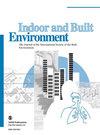Workplace induced heat-related-illness and kidney disorders among coal cutters of underground mines
IF 3.2
3区 工程技术
Q2 CONSTRUCTION & BUILDING TECHNOLOGY
引用次数: 0
Abstract
Workers in hot underground coal mines could develop heat-related illnesses, (especially skin, digestion and kidney problems), as compared to workers in non-hot mines. This study found severity of this situation by comparing heat illness symptoms, core body and skin temperature and kidney malfunctioning amongst workers of both types of mines. Ingestible thermometric pills (sending readings to Sensor Electronic Module every 15 s), skin temperature probes (connected to various body parts and sending readings to loggers) and laboratory analysis of pre- and post-shift samples of blood and urine, US-NIOSH-HETA-2012 sheet to survey symptoms, were used to collect data from 50 workers (25 from five hot mines (G1) and 25 from five non-hot mines (G2)). Two mine groups showed significant differences ( p-value <.001) regarding wet-bulb globe temperature, dry-bulb temperature and relative humidity. The highest core body temperature was 38.8°C in G1 and 37.9°C in G2. In intra-group comparison for kidney functioning, post-shift samples showed haematocrit (%) was reduced to 43.6 ± 2.1 from 45.4 ± 1.4 in G1 and to 44.0 ± 2.9 from 45.0 ± 0.75 in G2, and estimated glomerular filtration rate was reduced from 100 ± 19 to 94 ± 0 mL/min/1.72 m2 in G1 and to 113 ± 15 from 115 ± 19a in G2 workers. The comparison showed hot mines could induce heat-related illnesses which would necessitate intervention to reduce exposure.地下煤矿采煤工人因工作引起的热病和肾脏疾病
与非高温煤矿的工人相比,高温地下煤矿的工人可能会患上与高温有关的疾病(尤其是皮肤、消化和肾脏问题)。这项研究通过比较两类矿井工人的热病症状、核心体温和皮肤温度以及肾功能失调情况,发现了这种情况的严重性。研究使用了可摄入的测温药丸(每 15 秒向传感器电子模块发送一次读数)、皮肤温度探针(连接到身体各部位并向记录仪发送读数)以及班前和班后血液和尿液样本的实验室分析、US-NIOSH-HETA-2012 表来收集 50 名工人(25 名来自 5 个高温矿井 (G1) 和 25 名来自 5 个非高温矿井 (G2))的症状调查数据。两个矿井组在湿球温度、干球温度和相对湿度方面存在明显差异(p 值 <.001)。G1 组的最高核心体温为 38.8°C,G2 组为 37.9°C。在肾功能的组内比较中,班后样本显示血细胞比容(%)从 G1 的 45.4 ± 1.4 降至 43.6 ± 2.1,从 G2 的 45.0 ± 0.75 降至 44.0 ± 2.9,估计肾小球滤过率从 G1 的 100 ± 19 降至 94 ± 0 mL/min/1.72 m2,从 G2 的 115 ± 19a 降至 113 ± 15。比较结果表明,高温矿井可能诱发热相关疾病,因此有必要采取干预措施以减少接触。
本文章由计算机程序翻译,如有差异,请以英文原文为准。
求助全文
约1分钟内获得全文
求助全文
来源期刊

Indoor and Built Environment
环境科学-工程:环境
CiteScore
6.40
自引率
25.00%
发文量
130
审稿时长
2.6 months
期刊介绍:
Indoor and Built Environment publishes reports on any topic pertaining to the quality of the indoor and built environment, and how these might effect the health, performance, efficiency and comfort of persons living or working there. Topics range from urban infrastructure, design of buildings, and materials used to laboratory studies including building airflow simulations and health effects. This journal is a member of the Committee on Publication Ethics (COPE).
 求助内容:
求助内容: 应助结果提醒方式:
应助结果提醒方式:


